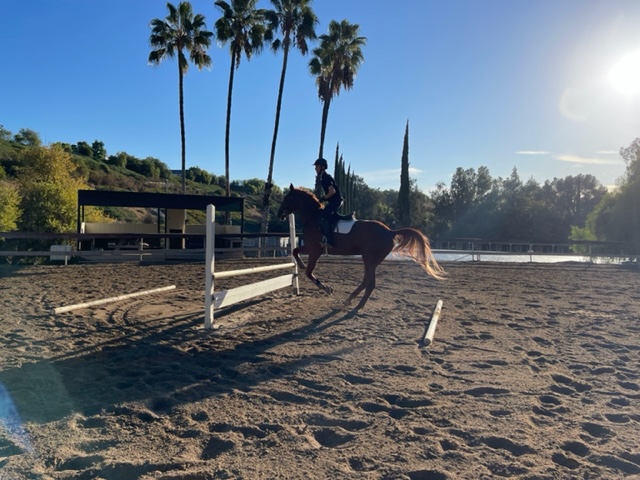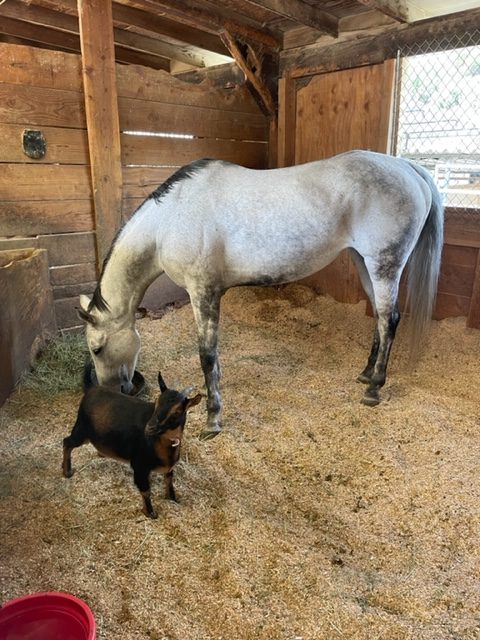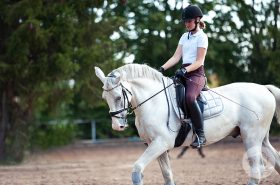Do you find your workout routine throughout the week beginning to feel rather basic? We all have practices and exercise programs that become boring to us after a while, and your horse can sympathize with you! For example, your usual gym class routines at school can make for a stale world of physical fitness. Secondly, are you tired of the same daily routine and think it is time to try a new activity? Do you think trying a new activity one or two days a week will be fun and benefits your health?
Like humans, horses enjoy the variation in their weekly routines and training programs. Remember, at first, your horse might not understand a new exercise, or your horse might resist at first when trying something new. But remember, similar to people, horses’ confidence levels vary, and some horses naturally have higher confidence levels than others during a new adventure. Other horses require more confidence-building from the rider and require a high level of confidence before your horse does the exercise confidently with a beginner rider safely and can be trusted to help the less advanced rider to learn a challenging new skill.

Be mindful that some horses prefer sticking to their accustomed routines, especially after many years. Awareness of your horse’s long-term wellbeing or health is most important, so if a modified routine or exercise causes your horse to begin immediate onset of new negative behavior, consider the context of the situation and possibly not changing your horse’s training program or routine for their long-term wellbeing. Forcing your dressage mount to become a lover of trail riding might not go over well and become a major headache for you instead!
A great example of how effective and beneficial cross-training can be for your horse; is a dressage horse who has begun to jump. Since the horse started to jump, the trainer has noticed the horse pushes into the contact with softer aids sooner and moves laterally off the leg in both directions well. As jumping encourages forward, it is no surprise that the benefits are overt in the horses’ flatwork due to incorporating jumping exercises in the dressage horse’s cross-training program.
New cross-training exercises can be challenging for your horse; however, added benefits of cross-training include an approach, which aims to assist in strengthening the partnership between rider and horse. Past challenges your horse encountered, which processed successfully, increase your horse’s confidence level and relaxation in new situations or when unexpected adventures arise. Always allow time for your horse to learn and perform a new exercise well, and do not rush your horse when teaching them a new activity. Remember, the rider’s job is to build your horse’s confidence and allow your horse up to be the successful and multifaceted athlete they are. Do not try and teach your horse something when you are in a hurry or in a context in which you can’t give the best considerations if needed to facilitate a positive learning experience and have a successful outcome and build confidence!

Your horse might express their excitement about trying something new and fun through their behaviors, such as springing extra high over a fence or throwing the rider a playful buck on a trail ride. Riders might notice their horse’s newfound willingness to try new adventures easier than previously because of their horse’s increased confidence level. Your horse likely will settle well into their new cross-training program after a minimal duration of becoming accustomed and increased behavior symptoms displaying enjoyment of their new program present. The rider’s patience during the implementation of the new routine is essential for the horse to continue to build confidence, because of continuous positive outcomes experienced during their learning process.
When adding jumping exercises to green horses or riders, I often suggest gymnastic pole exercises to start. The jumping exercise can be modified to any horse and rider combo and help increase the likeliness of a successful schooling session outcome when trying new training exercises. Modifying exercises simply with poles for green horses or riders or the exercise set at a varied height to incorporate a jumping exercise schooled on the horse’s flat day by simply adjusting the jumps as a cavaletti gymnastic. The exercise can be placed at varied low height for reduced stress on your horse’s body due to overjumping throughout the week or when the rider’s targeted goal is a focus on a specific skill and the goal is not related to higher height level. Ultimately, horses needs to learn to jump correctly and maintain excellent balance and self-carriage when jumping, so to ensure a happy, long, and physically sound career.
Cross-training benefits horses similar to humans because cross-training increases overall athletic abilities in athletes. Alternating training routines helps balance increased muscle soreness on repeated muscles experienced during your horse’s training like any athlete. Cross-training throughout the week ensures your horse receives a well-rounded weekly workout regime utilizing all their muscle groups. Regular outings on trails are great since your horse can enjoy getting out of the arena, and hill work helps strengthen your horse’s hind end. Incorporating more lateral work, dabbling in barrel racing, or teaching your horse to jump aid in various ways to improve your horse’s overall athletic abilities while learning a new discipline. You might notice positive changes in your horse’s disposition, physical soundness, and enjoyment of daily activities due to increased weekly cross-training exercises and varied schooling sessions or routines.
Lastly, awareness horses are similar to people and can become body sore. Horses can express this by severely resisting exercises or developing unpleasant attitudes or behaviors, so take note when changing routines or exercises. Like people, horses need to rest their muscles when sore and need a workout schedule encompassing a holistic approach of all your horse’s intersectionalities. A weekly training schedule mindful of altering the horse’s targeted muscle groups during training, helps to prevent constant muscle soreness and alters workout intensity levels. If financially possible, consider adding equine massage, acupuncture, or chiropractic work into your horse’s cross-training program. Maintaining a holistic approach and incorporating all of your horse’s intersectionalities aids their overall wellbeing. You and your horse are no basic team and require a multifaceted approach to ride at the team’s best. Your horse will thank you for considering all of their needs by happily performing at their top for you!
Do you have any cross-training routines you love? How do you vary your horse’s weekly routine, so your horse keeps at their best?



